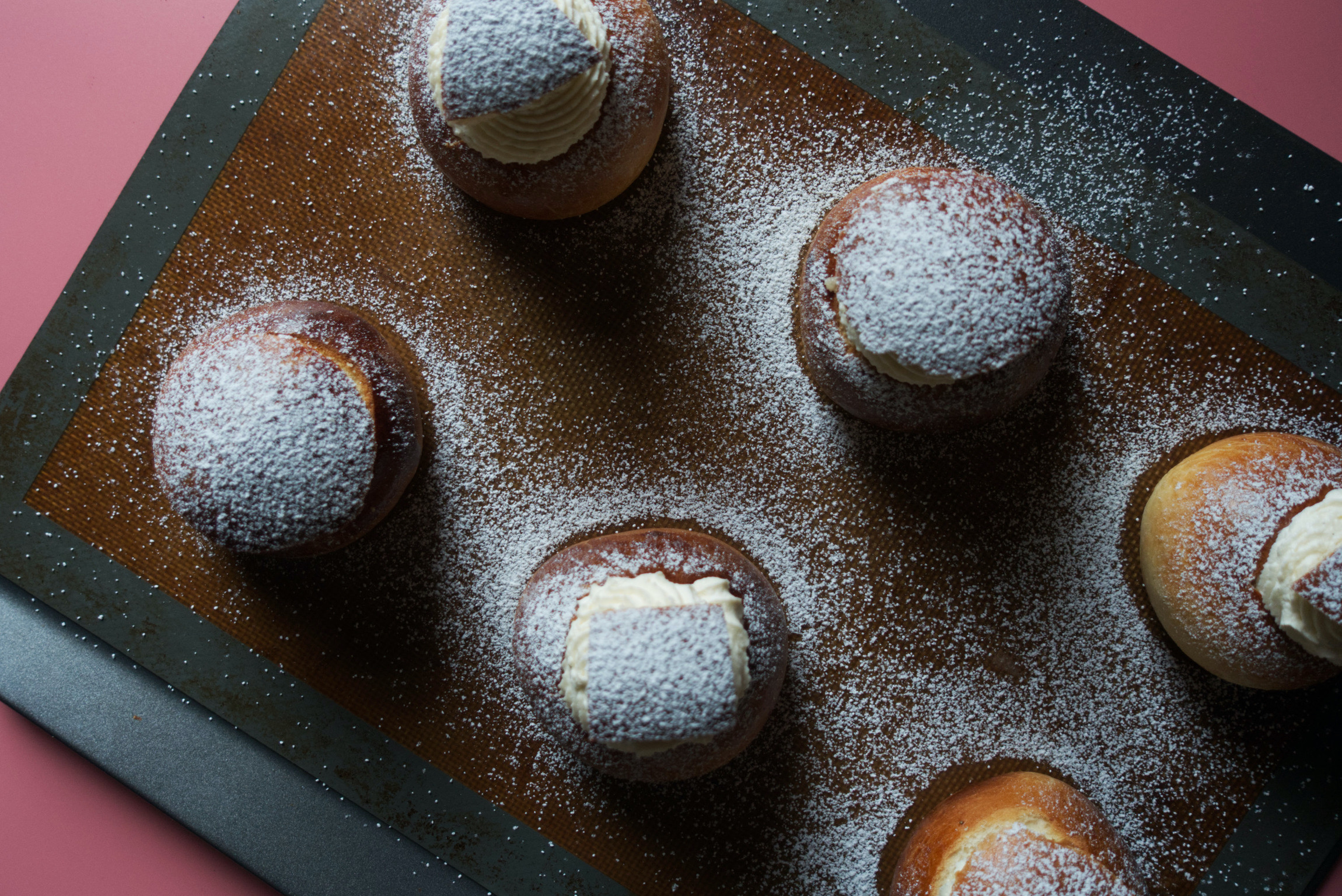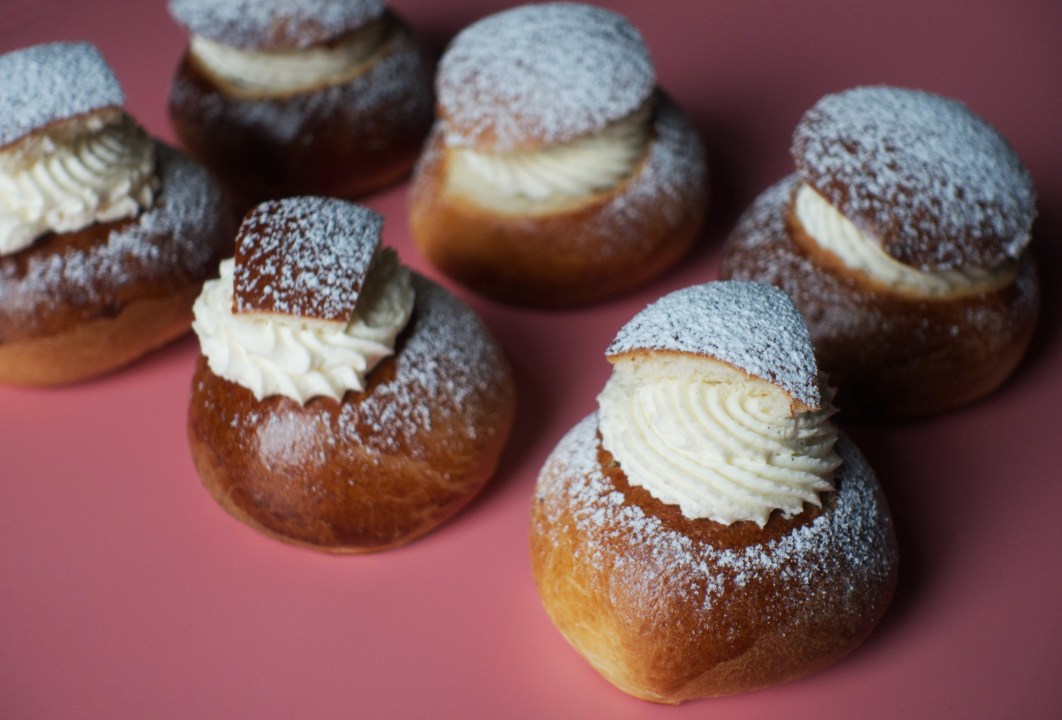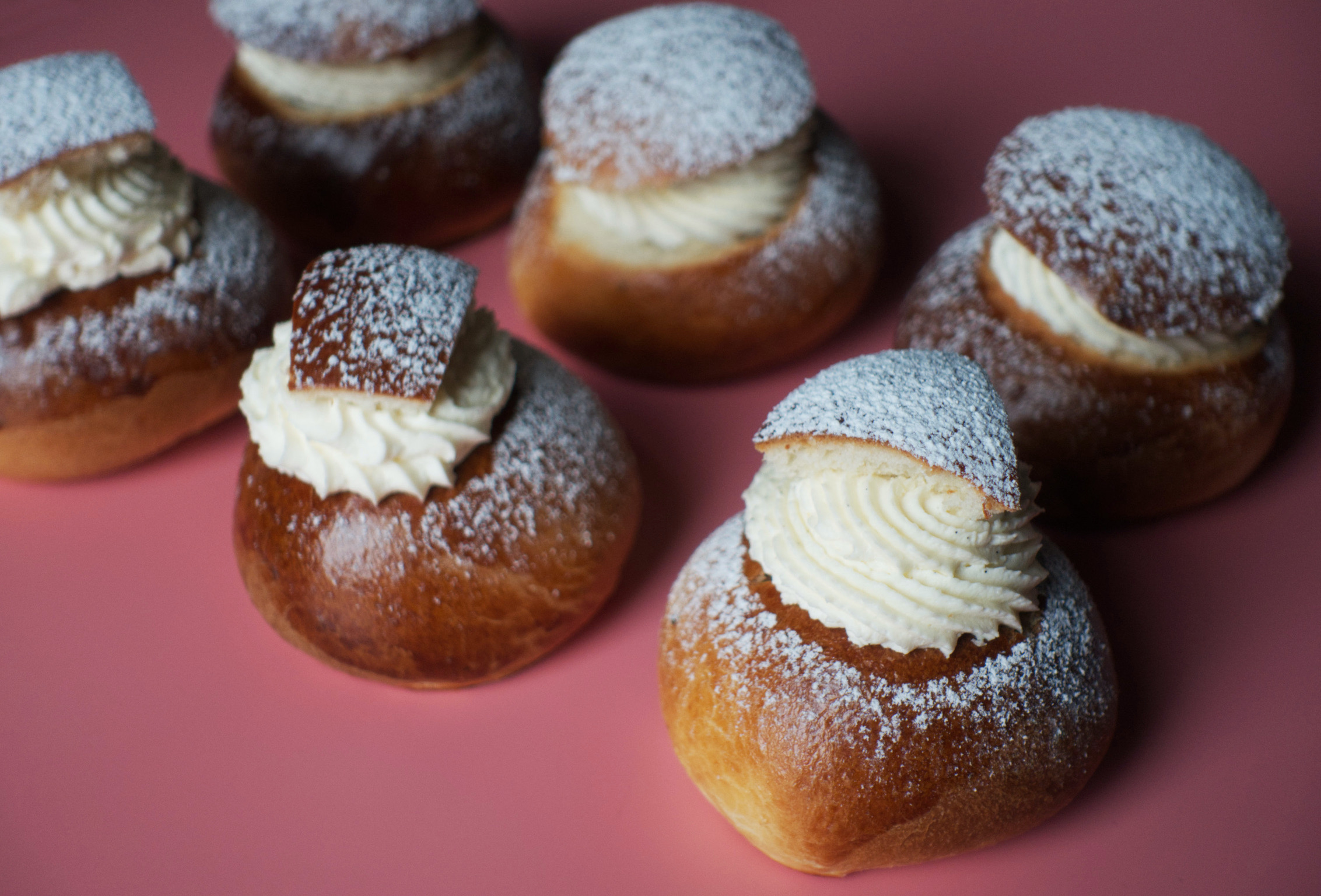In Britain, we mark the beginning of Lent with pancakes. Although nowadays relatively few of us strictly observe the Lenten dietary traditions which prohibit the eating of dairy and meat in the lead up to Easter, we happily leap on the annual opportunity to eat breakfast for dinner: sales of lemons and caster sugar soar, and we delight in filling ourselves full of pancakes.
But pancakes are not the only Lenten final hurrah: the semla bun is the Scandinavian favourite. Following the same logic as pancakes, the buns are designed to eat up the dairy ingredients which would have been prohibited by Lent religious laws.
Semlor buns (semlor is the plural, semla is singular) are cream buns made from an enriched bread dough, perfumed with ground cardamom and shaped into buns, before being filled with an almond paste and a chantilly cream. Versions of the bun are eaten across Nordic countries on Shrove Tuesday, but they are probably best known and loved in Sweden and Finland.
The buns have been eaten since the 1500’s, and were originally only eaten on fettisdag (literally ‘fat day’ or fat Tuesday), but in recent years, their popularity means that they are now made and sold by bakeries from Christmas right the way through Lent. In Finland, the almond paste is sometimes replaced with raspberry or strawberry jam, like a cardamom Devonshire split.
Some serve the bun soaked in warmed milk – this is a throwback to the early versions of the bun which didn’t use almond paste or cream. While I’m all for tradition, I prefer the bun in tact, with a swooping tower of cream – the taller, the better. Nowadays, the top of the bun is cut off, and a cavity scraped out; the cavity is then filled with an almond paste followed by a swirling tower of chantilly cream. The top of the bun is replaced, like a little lid, and then dusted with icing sugar.
If you’re not a marzipan lover, don’t be put off by the filling: it is smoothed out by the cream, and balanced by the cardamom-scented breadcrumbs. I like the peppery, smokiness of fresh cardamom, bashed in a mortar and pestle, unevenly freckled through the dough, and spiking the breadcrumbs for the marzipan filling – there’s something quite soothing about the kitchen task of cracking the pods, and peeling it away from around the seeds – but ready ground cardamom will work perfectly well.
A word of warning: these buns are so delightful that they can lead to dangerous excess. The death of King Adolf Fredrik of Sweden in 1771 is often attributed to an overconsumption of semlor buns – but, to be fair, he did have 14 of them, and preceded them with a feast of lobster, caviar, sauerkraut, kippers and champagne.
The buns should be eaten on the day of assembly, as they contain fresh cream, but the uncut buns can be frozen after baking, and defrosted and assembled at a later date.
For other Shrove Tuesday treats, you can find recipes here for traditional pancakes, thick American-style buttermilk pancakes, Dutch babies, and scotch pancakes.

Semlor Buns
A word of warning: these buns are so delightful that they can lead to dangerous excess. The death of King Adolf Fredrik of Sweden in 1771 is often attributed to an overconsumption of semlor buns.
Makes: 9
Takes: 30 minutes, plus proving
Bakes: 10 minutes
For the buns
350g strong white bread flour
7.5g dried, instant yeast
150ml whole milk
1 egg
½ teaspoon ground cardamom
40g caster sugar
½ teaspoon salt
1 teaspoon baking powder
80g butter, soft
1 egg yolk, to glaze
For the almond paste
100g marzipan
2 tablespoons double cream
Crumbs, reserved from buns
For the cream
200g double cream
50g icing sugar
½ teaspoon vanilla paste
- Place all the dough ingredients except the butter in a large mixing bowl, or the bowl of a stand mixer. Mix them into a dough, and knead for 5 minutes until the dough is smooth and elastic. Knead in the butter in four additions, each time thoroughly mixing in the piece before adding the rest.
- Divide the dough into 9 even pieces. Take one of the pieces, flatten it with the palm of your hand, then fold the edges into the middle. Turn the ball over so that the seam is on the work surface, and the smooth side if facing up. Cage your hand over the ball: make fast small circular motions over the ball of dough. This will smooth the ball of dough, and tighten it. Transfer to a lined baking tray, and repeat with the other pieces of dough, spacing well apart.
- Cover the tray of dough balls lightly with a piece of clingfilm, and leave to prove for 90 minutes, until the dough balls are visibly increased in size.
- Preheat the oven to 220°C. Remove the clingfilm and brush each of the buns gently with egg yolk. Bake for 10 minutes until the buns are golden, taut and puffed. Leave to cool completely.
- Using a sharp knife cut a piece from the top of the bun – this can just be the very top of the bun, or you can cut it into a shape, like a triangle or square. Reserve the piece you’ve cut away, and use a knife or teaspoon to dig out a cavity from the bun, about a third the depth of the whole bun.
- Mix the breadcrumbs you’ve removed with the marzipan and 2 tablespoons of double cream, to form a thick paste. Divide the almond paste between the bun cavities.
- Whisk the cream with icing sugar and vanilla paste to medium peaks, so that the cream holds its own weight. Spoon the cream into a piping bag fitted with a large, open star nozzle.
- Pipe tall swirls of the cream directly on top of the almond paste. Place the reserved bun tops on the swirl of cream, dust with a little extra icing sugar, and serve. The buns are best eaten on the day of assembly.







Comments